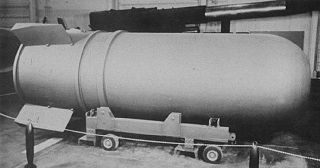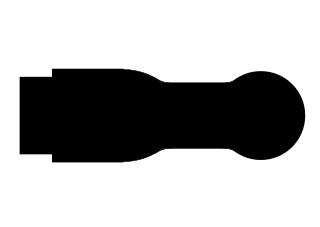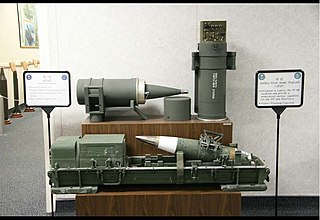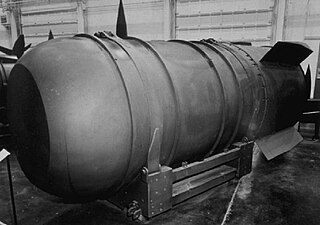Related Research Articles

Operation Nougat was a series of 44 nuclear tests conducted at the Nevada Test Site in 1961 and 1962, immediately after the Soviet Union abrogated a testing moratorium, with the US' Mink test shot taking place the day before the Soviets test-detonated the Tsar Bomba. Most tests were limited-yield underground test shots. New designs would be further developed in atmospheric testing during Operation Dominic I and II.

Operation Upshot–Knothole was a series of eleven nuclear test shots conducted in 1953 at the Nevada Test Site. It followed Operation Ivy and preceded Operation Castle.

The B-41 was a thermonuclear weapon deployed by the United States Strategic Air Command in the early 1960s. It was the most powerful nuclear bomb ever developed by the United States, with a maximum yield of 25 megatons of TNT. A top secret document, states “The US has stockpiled bombs of 9 MT and 23 MT...” which would likely be referring to the B-41's actual yield(s). The B-41 was the only three-stage thermonuclear weapon fielded by the U.S.

The W88 is an American thermonuclear warhead, with an estimated yield of 475 kilotonnes of TNT (1,990 TJ), and is small enough to fit on MIRVed missiles. The W88 was designed at the Los Alamos National Laboratory in the 1970s. In 1999, the director of Los Alamos who had presided over its design described it as "the most advanced U.S. nuclear warhead". As of 2021, the latest version is called the W88 ALT 370, the first unit of which came into production on 1 July, 2021, after 11 years of development. The Trident II submarine-launched ballistic missile (SLBM) can be armed with up to eight W88 warheads or twelve 100 kt W76 warheads, but it is limited to eight warheads under the Strategic Offensive Reductions Treaty.

Mark 7 "Thor" was the first tactical fission bomb adopted by US armed forces. It was also the first weapon to be delivered using the toss method with the help of the low-altitude bombing system (LABS). The weapon was tested in Operation Buster-Jangle. To facilitate external carry by fighter-bomber aircraft, Mark 7 was fitted with retractable stabilizer fins. The Mark 7 warhead (W7) also formed the basis of the 30.5 inches (775 mm) BOAR rocket, the Mark 90 Betty nuclear depth charge, MGR-1 Honest John rocket, and MGM-5 Corporal ballistic missile. It was also supplied for delivery by Royal Air Force Canberra aircraft assigned to NATO in Germany under the command of SACEUR. This was done under the auspices of Project E, an agreement between the United States and the UK on the RAF carriage of US nuclear weapons. In UK use it was designated 1,650 lb. H.E. M.C. The Mark 7 was in service from 1952 to 1967(8) with 1700–1800 having been built.

The W50 was an American thermonuclear warhead deployed on the MGM-31 Pershing theater ballistic missile. Initially developed for the LIM-49 Nike Zeus anti-ballistic missile, this application was cancelled before deployment. The W50 was developed by Los Alamos National Laboratory. The W50 was manufactured from 1963 through 1965, with a total of 280 being produced. They were retired from service starting in 1973 with the last units retired in 1991.
The B46 nuclear bomb was an American high-yield thermonuclear bomb which was designed and tested in the late 1950s. It was never deployed. Though originally intended to be a production design, the B46 ended up being only an intermediate prototype of the B-53 and was test fired several times. These prototypes were known as TX-46 units (Test/Experimental).
The Tsetse was a small American nuclear bomb developed in the 1950s that was used as the primary in several US thermonuclear bombs and as a small stand-alone weapon of its own.

The W58 was an American thermonuclear warhead used on the Polaris A-3 submarine-launched ballistic missile. Three W58 warheads were fitted as multiple warheads on each Polaris A-3 missile.

The W91 was an American thermonuclear warhead intended for use on the SRAM-T variant of the AGM-131 SRAM II air to ground missile.
Kinglet was a boosted fission primary used in several American thermonuclear weapons.

The W74 warhead, also known as XM517, was an American nuclear artillery shell that was cancelled before production.

The W82 was a low-yield tactical nuclear warhead developed by the United States and designed to be used in a 155 mm artillery shell. It was conceived as a more flexible replacement for the W48, the previous generation of 155 mm nuclear artillery shell. A previous attempt to replace the W48 with the W74 munition was canceled due to cost.

The W42 was an American nuclear fission weapon developed in 1957.
The W60 was nuclear warhead developed for the United States Navy's long range Typhon LR surface-to-air missile.
The Koon shot of Operation Castle was a test of a thermonuclear device designed at the University of California Radiation Laboratory (UCRL), now Lawrence Livermore National Laboratory (LLNL).
The W64 nuclear warhead was the Los Alamos Laboratory's entry into a brief competition between Lawrence Livermore Laboratory and Los Alamos to design an "enhanced-radiation" nuclear warhead for the United States Army's MGM-52 Lance tactical surface-to-surface missile. In July 1964, both Livermore Labs and Los Alamos started developing competing warheads for the Lance. The Los Alamos design, the W64, was canceled in September 1964 in favor of Livermore's W63. In November 1966, the W63 was canceled in favor of the W70, the model that finally entered production.

The Mk 36 was a heavy high-yield nuclear bomb designed in the 1950s. It was a thermonuclear, using a multi-stage fusion secondary system to generate yields up to about 10 megatons TNT equivalent.

Chuck Hansen was the compiler, over a period of 30 years, of the world's largest private collection of unclassified documents on how America developed atomic and thermonuclear weapons.

Operation Dominic was a series of 31 nuclear test explosions with a 38.1 Mt (159 PJ) total yield conducted in 1962 by the United States in the Pacific. This test series was scheduled quickly, in order to respond in kind to the Soviet resumption of testing after the tacit 1958–1961 test moratorium. Most of these shots were conducted with free fall bombs dropped from B-52 bomber aircraft. Twenty of these shots were to test new weapons designs; six to test weapons effects; and several shots to confirm the reliability of existing weapons. The Thor missile was also used to lift warheads into near-space to conduct high-altitude nuclear explosion tests; these shots were collectively called Operation Fishbowl.
References
- 1 2 3 Hansen, Chuck (2007). Swords of Armageddon - Volume I. Chukelea Publications. p. 398. ISBN 978-0-9791915-1-0.
- ↑ Hansen, Chuck (2007). Swords of Armageddon - Volume VII. Chukelea Publications. p. 377. ISBN 978-0-9791915-7-2.
- ↑ Hansen, Chuck (2007). Swords of Armageddon - Volume V. Chukelea Publications. p. 15. ISBN 978-0-9791915-5-8.
- ↑ Hansen, Chuck (2007). Swords of Armageddon - Volume VI. Chukelea Publications. p. 377. ISBN 978-0-9791915-6-5.